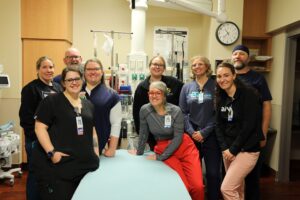Do you ever think about your bone health? You wouldn’t be alone if you said no. It’s not the first thing that springs to mind when you think about staying healthy. While you may not think about it often, it’s a very important factor in your wellness and length of life. May is Osteoporosis Awareness and Prevention Month, so we had Fairview Range’s Senior Staff Technologist Kirsten Olson and Grand Itasca Clinic & Hospital’s PACS Manager Angel Bradshaw cover your most common questions. Both locations offer DEXA bone density scans for patients.
What is Osteoporosis?
Osteoporosis is a disease of the bone.
“It occurs when the body loses too much bone, makes too little bone, or both,” explains Bradshaw. “As a result, bones become weak and may break from a fall or, in serious cases, from sneezing or minor bumps.”
As PACS Manager, Bradshaw has overseen DEXA scans and medical photography for 22 years. She is certified in bone density technology with a focus on bone densitometry from the International Society of Clinical Densitometry.
“Your bones are supposed to reconstruct when they break down,” explains Olson. “With osteoporosis, your bones are breaking down faster than they are building themselves back up, leading to a higher risk of fractures.”
Fractures are often overlooked because a bone fracture can sound non-life-threatening. But in reality, fractures at an older age can have a big impact. Around 33% of people over 50 who fracture their hip die within 12 months.
“Fragility fractures are one of the most common causes of disability and a major contributor to costs of medical care in all regions of the world. Clinical consequences of fracture include short and long-term morbidity characterized by pain, limitation of function, decreased health-related quality of life, and increased mortality.” – National Library of Medicine
“Everyone knows someone who has broken a bone at an older age,” says Bradshaw. “It’s extremely common but no one really talks about it. It’s so important more people realize what osteoporosis is and how to better their bone health.”
How many people does it impact?
According to the Bone and Osteoporosis Foundation, 10 million Americans over 50 have osteoporosis and another 44 million have low bone density.
“Most people are not aware that bone fractures related to osteoporosis are responsible for more hospitalizations than heart attacks, strokes, and breast cancer combined.” – Bone and Osteoporosis Foundation
Unfortunately, women have a much higher chance of developing osteoporosis earlier than men. Due to hormonal changes caused by menopause, bone density can decrease for women when they hit around 45 or 50 or the first three to five years of menopause. This is typically when your provider will start recommending getting tested. Typically, men do not need testing until around age 70.
A person may want to speak to their provider about bone health if they have one or more of the following risk factors:
- Post-menopausal age
- Low calcium diet
- Lack of regular exercise
- Caucasian or Asian ethnicity
- Petite or slender build
- Family history of osteoporosis
- Tobacco use
- Alcohol abuse
- Eating disorders
- Excessive caffeine consumption
- Use of certain medications such as steroids, thyroid hormones, and diuretics
- Loss of height
- Previous fractures from minor trauma
How do you get tested for osteoporosis or low bone density?
During your annual visit with your provider, you can ask them about osteoporosis and getting tested. Most insurances cover a bone density screening every two years. They will usually give you a referral for a test with a certified bone densitometry technologist (CBDT).
Once there, you will get a bone density scan. This should take no more than 10 minutes and involves zero needles. Using a dual-energy x-ray absorptiometry (DEXA), the provider will check your bone density and health.
“When performing DEXA scans, I ask the patient a short health questionnaire, position them on the exam table and perform the scan,” explains Olson. “The images are sent to a Picture Archiving Communication System (PACS), where a radiologist can interpret the data/images and dictate a report for the ordering provider.“
How do you prevent Osteoporosis?
While osteoporosis is very impactful, it is also very preventable. It all starts with good bone health.
- Take Bone-Strengthing Vitamins
- Calcium*
- Vitamin D
- Magnesium
- Vitamin K
*You should split up calcium intake throughout the day. The body can only absorb 500mg about every four hours.
- Eat Vitamin-Rich Foods
- Almonds
- Broccoli
- Spinach
- Milk
- Yogurt
- Cheese
- Other green veggies
- Weight-bearing Exercise
- Running
- Walking
- Jump rope
- Tennis
- Pickleball
- Step aerobics
- Outside chores like raking and mowing the lawn
“Some local YMCAs and gyms offer bone-building exercise classes,” shares Bradshaw. “I highly recommend trying one out if you’re concerned about osteoporosis.”
How do you improve osteoporosis if diagnosed?
There are several ways to improve bone health after an osteoporosis diagnosis. It’s not too late to start taking vitamins like calcium and vitamin D. Your provider will help you figure out which medications are right for you. For some people, it’s meds taken weekly or monthly, shots, or IV infusions. It all depends on the specific person and their needs. After about one to two years of treatment, you will be evaluated to see if bone density is improving.
Improve Your Bone Health Today
No matter your age, it’s always a good time to improve your bone health. We recommend following our preventative advice and asking about a bone density scan at your next visit if you’re a woman 45+ or a man 70+. You can be tested for osteoporosis easily and fast at both Fairview Range in Hibbing and Grand Itasca Clinic & Hospital in Grand Rapids.


